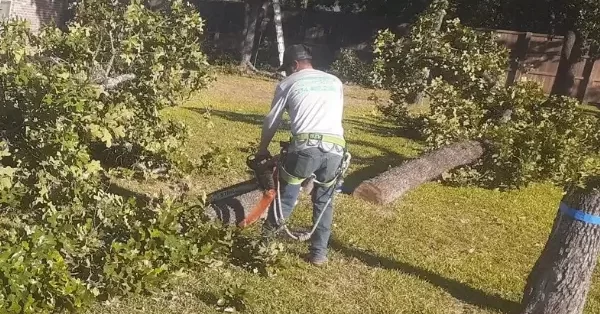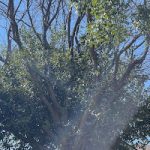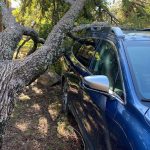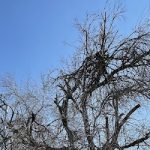
How to Spot, Prevent, and Handle Tree Problems in North Texas
July 10, 2025
Denton and the wider DFW area deal with some tough conditions when it comes to tree health. Heavy clay soil, prolonged summer heat, drought cycles, and sudden storms all contribute to a specific set of challenges for local trees. If you’re a homeowner in North Texas, you’ve likely seen some of these issues show up in your yard dead branches, leaning trunks, or insect damage.
This guide breaks down the most common tree problems across Denton and the DFW region. You’ll learn how to spot warning signs early, reduce risks, and take smart steps to protect your trees year-round.
Dead or Dying Branches
Brittle limbs or branches that don’t leaf out in spring are often the first signs that something’s wrong. These dead branches can fall without warning, especially during storms.
What to do: Remove dead limbs promptly to reduce risk. For high or large branches, hire a professional tree care service.
Soil Compaction and Root Damage
Denton’s clay soil drains poorly. During rain, it holds water. In drought, it compacts and cracks. Both conditions stress tree roots, especially young or shallow-rooted species.
What to do: Use mulch to maintain moisture and reduce soil pressure. Avoid driving or walking over the root zone. If the soil is heavily compacted, consider aeration.
Leaning Trees or Shifting Trunks
A tree that starts leaning or shifts position after a storm may have root issues or be structurally unstable.
What to do: Monitor the tree for changes in tilt or soil heaving. If the lean gets worse or poses a risk, call in a tree professional for evaluation or safe removal.
Insect Pests and Tree Diseases
Aphids, webworms, and scale insects are common in North Texas. Fungal infections like oak wilt and root rot are also frequent, especially in poorly drained areas.
What to do: Look for webbing, spots, or sap on leaves. Prune infected areas, water deeply but infrequently, and improve drainage where possible.
Overgrown Tree Canopies
Dense canopies block sunlight and airflow, which leads to pest infestations, weak growth, and higher risk of breakage during storms.
What to do: Thin the canopy to promote better air circulation and reduce wind resistance. Make clean, strategic cuts to avoid stressing the tree.
Trees Growing Too Close to Buildings
Trees planted too close to homes, fences, or driveways can cause structural problems. Roots may lift concrete, and branches can damage roofs and siding.
What to do: Trim back overhanging limbs. Avoid planting large trees within 15 feet of structures. For mature trees already in place, consider root barriers or professional trimming.
Storm Damage
Spring and summer storms in Denton can split trunks, tear off large limbs, or topple entire trees.
What to do: Inspect trees after every major storm. Look for cracks, exposed roots, or hanging branches. Damaged trees should be stabilized or removed quickly to prevent further hazards.
Improper Pruning Practices
Bad cuts like topping or flush cuts leave trees vulnerable to decay and long-term damage. Over-pruning can stress the tree and invite disease.
What to do: Follow proper pruning techniques. Never remove more than 25 percent of the canopy at once. Always cut just outside the branch collar to allow healing.
Nutrient Deficiency in Trees
If leaves are yellowing, small, or falling early, the tree might lack key nutrients. Poor soil quality is often the root cause.
What to do: Test your soil to identify nutrient gaps. Apply slow-release fertilizers designed for tree health. Mulch regularly to enrich the soil over time.
Trees Interfering with Power Lines
When branches grow too close to utility lines, it’s a safety hazard. It may also be the utility company’s responsibility to maintain clearance.
What to do: Never attempt to prune near power lines yourself. Contact your utility provider if you see a hazard.
Tree Suckers and Water Sprouts
Suckers (shoots from the base) and water sprouts (upright shoots on branches) drain energy and create weak points in the tree structure.
What to do: Remove suckers and water sprouts promptly. Use clean, sharp tools and make cuts close to the origin point.
Girdling Roots
Girdling roots wrap around the trunk or major roots, choking off water and nutrient flow. This can lead to slow decline or sudden death.
What to do: Look for roots circling the base of the trunk. Expose the root collar and cut girdling roots with care. This may require professional help.
Tree Trunk Damage from Lawn Equipment
Repeated bumps from lawnmowers or string trimmers can injure tree bark and open the door to pests and decay.
What to do: Maintain a wide, mulch-covered area around the trunk. Keep lawn tools at a safe distance from the base of the tree.
Common Tree Issues and Actions
| Tree Problem | Signs to Watch For | Action You Can Take |
| Dead limbs | Bare branches, brittle wood | Prune or remove safely |
| Soil/root damage | Soil cracking, tree leaning | Aerate, mulch, protect root zone |
| Pest infestations | Webbing, leaf spots, sticky sap | Prune, water properly, improve airflow |
| Too close to house | Roots in concrete, limb damage | Trim, install root barriers |
| Storm damage | Split trunk, hanging branches | Inspect, prune, or remove |
Problematic Tree Species in Denton
Not all trees thrive in North Texas. These species often struggle in Denton’s climate:
- Silver Maple: Grows fast but breaks easily
- Bradford Pear: Common but prone to splitting in wind
- Leyland Cypress: Sensitive to drought and root rot
Better options include Cedar Elm, Bur Oak, Chinquapin Oak, and other native species.
Early Signs of Tree Decline
Spotting problems early can save the tree and reduce costs. Watch for:
- Sparse or discolored leaves
- Cracks or peeling bark
- Mushrooms growing at the base
- Branch drop in calm weather
- A lean that’s slowly getting worse
Long-Term Tree Care Tips for Denton Yards
Trees need more than occasional pruning. Consistent care keeps them strong and storm-resistant.
- Prune annually to maintain structure
- Keep a mulch ring around the base
- Fertilize with slow-release nutrients if needed
- Test soil every few years
- Avoid mower and foot traffic over roots
Frequently Asked Questions
What’s the most common tree issue in Denton?
Clay soil. It holds water in the wet season and compacts hard during drought. This stresses roots and leads to other problems.
How often should I inspect my trees?
At least once a year. Check again after major storms or if the tree is near your home.
Can I prune trees myself?
Small limbs, yes. For anything over two inches thick, or near power lines, hire a pro.
Are all tree problems fixable?
Not always. Early issues like pests or nutrient deficiencies can be managed. Structural damage may not be reversible.
What’s the safe distance to plant trees from a house?
At least 15 to 20 feet for larger species. Always plan with root spread in mind.
How do I choose the right tree for my yard?
Start with native species that thrive in North Texas soil and weather. Look for trees with strong limbs, deep roots, and low maintenance needs.
What’s the best time of year to plant a new tree in Denton?
Fall is ideal. Cooler temperatures reduce stress on young trees and give roots time to establish before summer heat arrives.
Final Takeaway
Trees are a big asset to any Denton property, but they need the right care to stay healthy. From soil issues to storm damage, most tree problems show up gradually. Regular checks, proper pruning, and early action can make all the difference. If something looks off with your tree, don’t wait. A quick assessment now can prevent major headaches and costs later.






